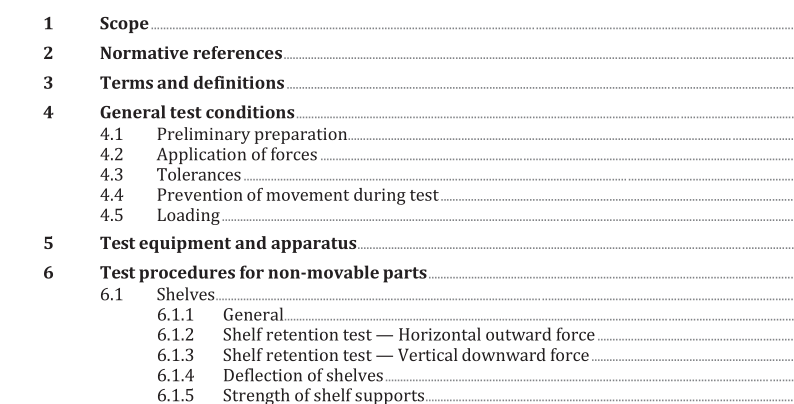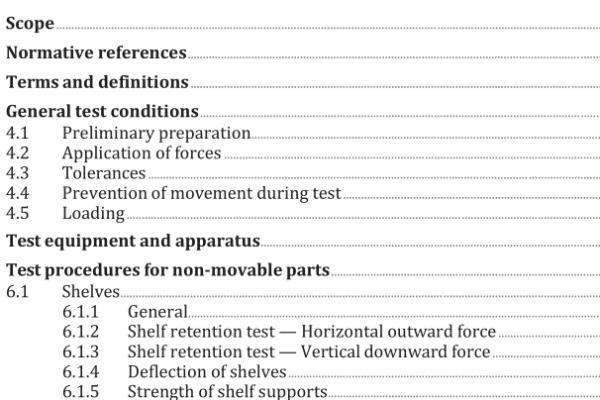ISO 7170:2021 pdf download – Furniture — Storage units — Test methods for the determination of strength, durability and stability.
1 Scope This document specifies test methods for determining the strength, durability and stability of storage units, when fully assembled prior to use, including their movable and non-movable parts. Acceptance criteria for the strength, durability and stability of the storage furniture is not specified by the test methods. Instead, suggested loads, cycles and forces are provided in Annex B, depending on the applicability of the furniture. 2 Normative references The following documents are referred to in the text in such a way that some or all of their content constitutes requirements of this document. For dated references, only the edition cited applies. For undated references, the latest edition of the referenced document (including any amendments) applies. ISO 48-5:2018, Rubber, vulcanized or thermoplastic — Determination of hardness — Part 5: Indentation hardness by IRHD pocket meter method 3 Terms and definitions For the purposes of this document, the following terms and definitions apply. ISO and IEC maintain terminological databases for use in standardization at the following addresses: — ISO Online browsing platform: available at https://www.iso .org/obp — IEC Electropedia: available at https://www.electropedia .org/ 3.1 adjustable friction stay component (3.7 ) to hold open a door or a flap (3.13) with a feature that keeps the door or flap open without any further assistance at a multitude of positions 3.2 bracket rigid device to prevent overturning Note 1 to entry: Normally made of metal; not a flexible device such as strap or cable tie. 3.3 built-in stop device of the component (3.7 ) that limits the travel of extension element (3.12) or doors 3.4 catch device device that keeps or pulls a component (3.7 ) in place but does not require a second action in order to release it EXAMPLE A magnetic catch or a self-closing-mechanism.
3.12 extension element component (3.7 ) that can be pulled out and pushed in EXAMPLE Drawers, suspended pocket files, keyboard tray ( 3.25). 3.13 flap horizontally hinged door, which opens upwards or downwards 3.14 free-standing unit unit (3.27 ) not intended to be attached to a load bearing structure 3.15 height adjustment device adjustable device intended to enable height adjustment of a unit (3.27 ), such as a work surface 3.16 interlock device that restrains the opening of more than one extension element (3.12) at a time 3.17 latching mechanism mechanism that retains an extension element (3.12) or a door in the closed position and that requires a second action to release it and can require a key or a combination in order to activate it 3.18 levelling device adjustable device intended to keep an item of furniture horizontal with a limitation of 40 mm of vertical range EXAMPLE Adjustable feet or similar. 3.19 locking mechanism mechanism that limits access to the interior of a unit (3.27 ) or a storage element and that requires a key or a combination in order to activate it or to make it possible to activate it 3.20 overturn condition where an unrestricted storage unit (3.27 ) does not return to its upright normal position 3.21 runners component (3.7 ) that is used to facilitate the movement of an extension element (3.12) Note 1 to entry: Includes smooth surfaces, roller and ball bearing slides. 3.22 self-locking stay component (3.7 ) to hold open a door or a flap (3.13) with a feature that keeps the door or flap open without any further assistance 3.23 structural member component (3.7 ) to enhance the strength of the assembled unit (3.27 )
ISO 7170:2021 pdf download – Furniture — Storage units — Test methods for the determination of strength, durability and stability






